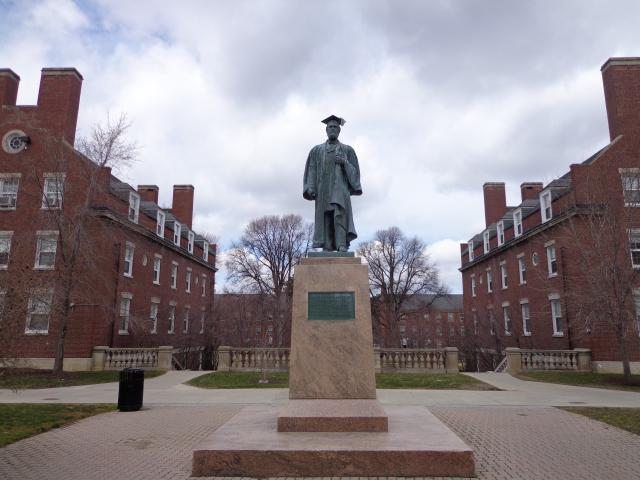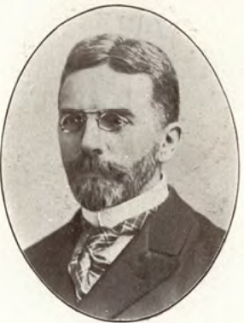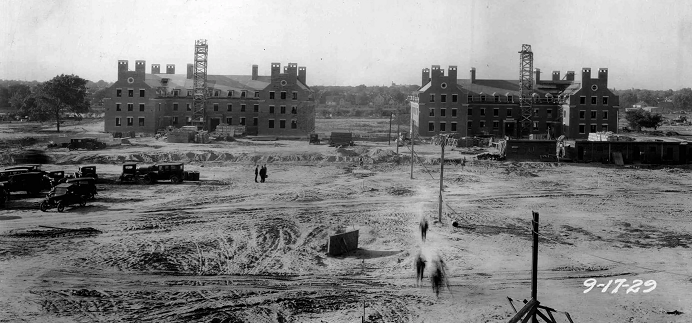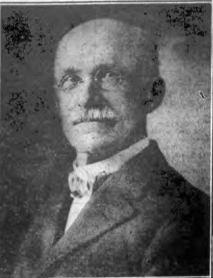
| River Campus | Burton & Crosby Halls |
 |
| Statue of the Martin B. Anderson, first president of the
University, was erected on the Prince Street campus in 1904 and
moved to its present location in front of Burton and Crosby in July
1955. |
 |
 |
 |
| Henry Fairchild Burton | Burton and Crosby dormitories under construction in 1929. | George Nelson Crosby |
Burton and Crosby dormitories were opened in October 1930. In 1955 the statue of the first university president, Martin B. Anderson, was relocated from the Prince Street Campus to the front of Burton and Crosby.
Burton was named Henry Fairfield Burton, Professor of Latin, who also taught Sanskrit. He was also acting President from 1898 to 1900 and was recommended for president, but disliked "executive duties and responsibilities." His wife, Marion Williams Perrin Burton, was president of the Rochester Anti-Suffrage Society, but became a prominent political figure in Monroe County after the Nineteenth Amendment passed,
Crosby was named after George Nelson Crosby of Rochester, who founded a large tanning-furrier business. Upon his death his estate was to be left to his wife with the understanding that when she died the remainder of the estate would be divided between the University and RIT. Mrs. Crosby died in 1925 while the fundraising for the River Campus was underway. The Crosby bequest went towards this end and when the campus opened in 1930 one of the new dormitories was named after him..
Both dormitories were extensively renovated in 1983.
References
1894 "Rome in Paul's Day,"
Henry F. Burton, The Biblical World 3(2):87-96 (February, 1894)
1895 Ancient Or Modern Languages: Which Should Precede in School and College Courses?, by Henry Fairfield Burton
1909 "Seneca's Idea of God," by Henry Fairchild Burton, American Journal of Theology 13(3):350-369 (July 1909)
1912 "The Worship of the Roman Emperors," The Biblical World 40(2):80-91 (August 1912)
1918 Henry Fairfield Burton (1851-1918) Grave in Oak Ridge Cemetery, South Livonia, Livingston County, New York
1920 Literary and historical essays, by Henry F. Burton
1923 George
Nelson Crosby (1841-1923) Grave in Hillside Cemetery, Antwerp,
Jefferson County, New York.
His parents died when he was young and he still lived in Diana in 1850.
He lived in Antwerp for some time, then Gouverneur, but moved to Rochester
NY after going bankrupt in the tannery business.
He owned Crosby Frisian Tannery in Rochester and donated money to
establish the public library in Antwerp, NY which is named after him. He
also bequeathed money to the University of Rochester and Crosby Hall there
is named for him.
He died Oct. 23, 1923 in Rochester, NY and is buried in Hillside Cemetery
in Antwerp, NY.
1930 "Name
of Rush Rhees Given to New Library," Rochester Review
8(5):131-132 (June-July 1930)
Burton and Crosby Dormitories
Three giants of the older faculty have already been perpetuated in name on
buildings flanking the main quadrangle – Samuel Allan Lattimore, William
Carey Morey and Chester Dewey. Another name in that class, that of Henry
Fairfield Burton, is to be similarly perpetuated on one of the new
dormitory units, the building to the southwest which has heretofore been
designated as Dormitory "A."
Older alumni do not need to be reminded of the value of Professor Burton
to the faculty' which they knew, and of the consequent appropriateness of
this designation.
A great scholar and a great teacher in his field, he served the University
in the department of Latin for forty-one years, being assistant professor
from 1877 to 1883 and professor from 1883 to 1918. As acting president he
also conducted the affairs of the University very ably in the years 1898
to 1900 and again in 1908-09.
The other dormitory unit, known until the present as Dormitory "B," will
bear the name of. George Nelson Crosby, in recognition of his generous and
wholly unsolicited bequest to the University. Mr. Crosby was for a long
time president of the Crosby-Frisian Fur Company, of Rochester.
His interest in education was not generally known until the probate of his
will some time after his death in October, 1923, when it was discovered
that he had bequeathed the whole of his residuary estate to Mechanics
Institute and the University.
The half-share coming to the University has amounted to more than
$160,000, given without restrictions. A Civil War veteran of honorable
record, a man self-educated after his thirteenth year, who had worked for
seventy years, he came at the end to give the bulk of his fortune to the
cause of education. It is right that a college campus should do him honor.
1930 The
University of Rochester: A Story of Expansion and Its Background,
by Hugh A. Smith.
Page 17: The two beautiful dormitory units erected at the outset will house 189 students and also provide attractive quarters for the Faculty Club. The unit to the southwest bears the name of Henry Fairfield Burton, professor of Latin from 1877 to 1918, while the other is named after George Nelson Crosby, who bequeathed all of his residuary estate to education, the University receiving one-half, or more than $160,000.
1939 "Dorm
Nears Opening in UR Stadium," Democrat and Chronicle,
September 7, 1939, Page 16.
The dorm will accommodate 44 students. Sleeping quarters will be in
two large second-floor rooms in which 16 double and 12 single beds will be
placed. In addition, study rooms have been constructed on the first floor
to house two or three students each. Students will have their own desks,
wardrobes and lockers. Those assigned to the stadium rooms will pay $80 a
year as compared with $140 to $160 for single rooms and $280 to $300 for
double looms in Burton and Crosby dormitories. Heat will be furnished by
the University's central heating plant.
1955 "UR to move 10-ton statue of its 1st president today," Democrat and Chronicle, July 25, 1955, Page 18.
1977 History
of the University of Rochester, 1850-1962, by Arthur J.
May. Expanded edition with notes
Chapter 22, Oak Hill Becomes River Campus
A suggestion to reserve space in Todd Union for a faculty club was
considered, but turned aside in favor of a section for that purpose in one
of the two dormitories, erected on what was sometimes referred to as the
lower campus. These residence halls, of four floors each, had room for 189
occupants and memorialized Professor Henry F. Burton and George N. Crosby,
a largely self-educated Rochester businessman who bequeathed a substantial
legacy to the U. of R. Time revealed troublesome defects in the
dormitories: noise penetrated through walls," open stairwells invited
exhibitions of hooliganism," corridors were badly lighted; chairs were
less than comfortable and no rugs or bookcases were furnished. Playing
fields extended from the dormitories to the River Boulevard, close by the
Genesee.
Chapter 33, The First Century Ends
Notwithstanding the congestion in the dormitories--two men occupying rooms
intended for one--a few; University School students were assigned rooms
and the Faculty Club was restored in the west end of Burton Hall. State
aid financed a slight enlargement of living space in the Stadium
Dormitory, and the national government stepped in with money to alleviate
the housing headache. The Federal Public Housing Authority (1946)
allocated funds to build two makeshift T-shaped structures to accommodate
about 145 single war veterans, to the north of the existing dormitories,
and to lay out a similar housing complex for married veterans, their wives
and babies, on a Lattimore Road tract southwest of Helen Wood Hall;
administrative officers kept saying that more permanent residence halls
were urgently needed. The River Campus "barracks" with their thin walls
were noisy, making study and sleeping difficult, and protests were
registered almost daily. In 1950 the trustees agreed that drawings should
be prepared for additional dormitories, and recreation lounges were
blocked out in Burton and Crosby Halls.
1983 "Students
Will Live in Townhouse Next Fall," Campus Times, January 31,
1983, Page 1
Crosby and Burton will be renovated starting in May.
1983 "Dorm
renovations 'on schedule'," Campus Times, September 14,
1983, Page 1 | Part
2 |
The renovation of Burton and Crosby dorms is "basically on schedule;" said
Stuart Zellmer, director of residence halls.
Some parts of the renovation are ahead of schedule, while others are
behind, but "we anticipate a January opening," Zellmer said.
The 206 students now living in Towne House will have priority for rooms in
Burton and Crosby, he said. The renovated dorms will house a total of 243
students; the remaining room spaces will be filled by the normal room
change waiting list, he said.
Both Burton and Crosby will be coed when they reopen, but room and hall
arrangements regarding sex have not yet been determined, said Zellmer.
Freshmen will be assigned to Burton in the Fall 1984 semester and some may
be assigned to historically upperclass Crosby as well.
The remodeled rooms will contain "virtually new everything," Zellmer said.
The all-new solid oak furniture, custom made for the UR, will include
80-inch loftable beds. Each room will have a new sink, and desk telephones
will replace the standard wall phones.
New windows – double-glazed and aluminum-sealed – will be installed at
cost of over fifty dollars each, although not all windows will have
screens.
New solid board hung ceilings to be installed in hallways are intended to
be more damage resistant. The wooden wardrobes kept from before the
renovation and room doors will be refinished.
The renovation includes extensive changes in plumbing and heating systems,
as well as the installation of electrical tracks with the capability of
housing cable television and computer terminals in each room.
Entry to the renovated dorms will be by the key-card system now in use in
Anderson and Wilder Towers, said Zellmer.
Considerable attention will be given to protecting the UR's $3 million
renovation investment, said Zellmer. No student-built lofts will be
allowed. A cork pin-board and an erasable porcelain message board will be
mounted on the wall outside each room to preserve the new finish on room
doors.
Students will not be allowed to paint their rooms, and some restrictions
will apply to hanging objects on the walls, Zellmer said.
Each building will have a large lounge on one floor with a television and
kitchen; the other floors will have a smaller lounge with a kitchenette.
All lounges and corridors will be carpeted.
No students will remain in Towne House after Burton and Crosby re-open;
those students who move to a dorm other than Burton or Crosby will receive
an extra half point in the room lottery, Zellmer said.
Towne House residents will be moved during the first weeks of the Spring
semester, said Zellmer. A UR van will be available to help the students
transport their belongings.
Rooms in Burton and Crosby will be assigned by a lottery for Towne House
residents, Zellmer said.
Burton and Crosby will each have a faculty apartment on the top floor,
said Zellmer. The apartments, which each contain two bedrooms, a
kitchen-dining area, living room, and bath, are designed to house a
faculty member and his family, or, if necessary, six students.
Zellmer interviewed prospective faculty residents last Spring, he said,
but he has not yet made his selections.
Future Renovations There has not yet been a commitment by the Board of
Trustees to renovate any other dorms, Zellmer said.
The decision to renovate any other dorms will largely depend on the
success of the Burton and Crosby renovations, said Zellmer. The Trustees
will consider Residence Halls' ability to meet time and budget limitations
and the treatment given the buildings by their new residents, he said.
Phase is a possible candidate if any further renovations are made because
of trouble with heat loss and heat distribution, Zellmer said.
1983 "Burton and Crosby dorms will be co-ed by room," Campus Times, December 2, 1983, Page 1 | Part 2 |
1984 "The
wait and inconveniences were worth it," Campus Times,
January 23, 1984, Page 3
New Burton residents enjoy their renovated rooms, lounges.
2014 Women
Against Equality: A History of the Anti Suffrage Movement In the
United States from 1895 to 1920, by Anne Myra Benjamin
Page 370: Or consider the president of the Rochester (New York)
Anti-Suffrage Society, Mrs. Henry Fairfield Burton, who abruptly evolved
into the first woman vice chairn1an of the Monroe County Republican party
in the 1920's 27 and who exhorted her fellow women voters to support the
candidacy of U.S. Senator James W. Wadsworth, Jr. (in spice of his
relentless opposition to wo1nan suffrage and his wife's presidency over
the National).
"[Mrs. Burton] was an "anti" before the Nineteenth Amendment was passed.
But when women received the vote she was the person who organized all
feminine Republicans in Monroe County," marveled The Rochester
Democrat and Chronicle.
2020 Forgotten Firm: The Crosby Frisian Fur Company, by Cynthia Howk, Landmark Society of Western New York
© 2021 Morris A. Pierce